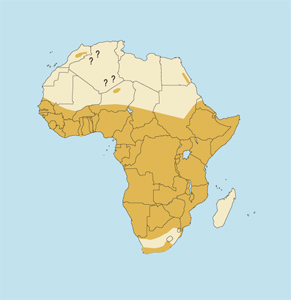 |
Panthera pardus pardus
DESCRIPTION Length, including tail, 5-1/2 to 7-1/2 feet (170-230 cm), occasionally more. Shoulder height 20-30 inches (51-76 cm). Weight (male) 80-160 pounds (36-73 kg), sometimes considerably more; (female) 60-130 pounds (27-59 kg). The female normally has four pairs of teats.
A large cat with a long body and comparatively short legs. Its dense yellowish coat is marked with numerous black spots grouped in rosettes. The tail is long and spotted, with black bands near the tip. There are five toes (including dewclaws) on the front feet, four on the hind feet, all with sharp, curved, retractile claws. Melanistic (black) individuals can occur in otherwise normal litters, especially in moist, dense forests; however, they are rare. Females are smaller and more lightly built than males, but are otherwise similar.
BEHAVIOR Leopards are normally solitary except when mating. They are territorial, with the range of the male including the range of one or two females. Territories are marked and defended against other leopards of the same sex. Breeding takes place throughout the year, with the female giving birth every year or two. The usual litter is 2-3 cubs (range is 1-6) who remain with the mother for 18-24 months and reach sexual maturity and full size at about three years. Longevity in the wild 10-15 years, in captivity usually 12-15 years. but sometimes as much as 20 years.
Usually nocturnal, resting by day on a tree branch or in cover. Entirely carnivorous, preying on small to medium-sized animals such as gazelles, impala, duikers, pigs, baboons, monkeys and domestic livestock. Also takes birds, rodents and rabbits, and will eat carrion. A very small percentage of leopards become man-eaters. Drinks daily when water is available, but can subsist for long periods on moisture obtained from prey animals.
Wary and secretive, with exceptional hearing, very good eyesight and a good sense of smell. Normally moves about in a slow, silent walk, but can run briefly at more than 37 mph (60 km/h). Reportedly able to leap 20 feet (6m) horizontally and 10 feet (3m) vertically. A very agile tree-climber, able to descend head first, and a good swimmer.
HABITAT Nearly all types from rain forest to subdesert, and from low plains to high mountains.
DISTRIBUTION Almost everywhere in Africa except the driest deserts.
REMARKS Any adult male leopard is a fine hunting trophy; consequently, it is far easier to find a good leopard than a good lion. The classic hunting method is by baiting, with the hunter waiting in a blind at twilight, and this provides the maximum in drama and suspense. Sometimes leopards can be tracked or called, and they are often encountered by chance. Usually not aggressive toward man, but very dangerous when wounded.
TAXONOMIC NOTES Smithers lists 12 subspecies of leopards in Africa: adersi, adusta, chui, iturensis, leopardus, melanotica, nanopardus, panthera, pardus, reichenowi, shortridgei and suahelica. We combine them, with pardus Linnaeus, 1758 having priority.
STATUS All leopards are on Appendix I of CITES. Leopards generally are listed as vulnerable by the IUCN, with the subspecies panthera (northwestern Africa) classified as endangered. All leopards are regarded as endangered by the USF&WS, except those in Africa south of the southern borders of Equatorial Guinea, Cameroon, Central African Republic, Sudan, Ethiopia and Somalia. South of this line they are listed as threatened, and sport-hunted trophies may be imported into the United States under the provisions of CITES.
Experienced observers of African fauna cannot help but wonder why the status of the leopard is regarded so negatively, for it is obvious that populations are healthy in many parts of the continent. Eaton (1977b) alluded to the leopard as the "coyote of Africa," predicting it would be one of the last major species to survive on that continent.
|





